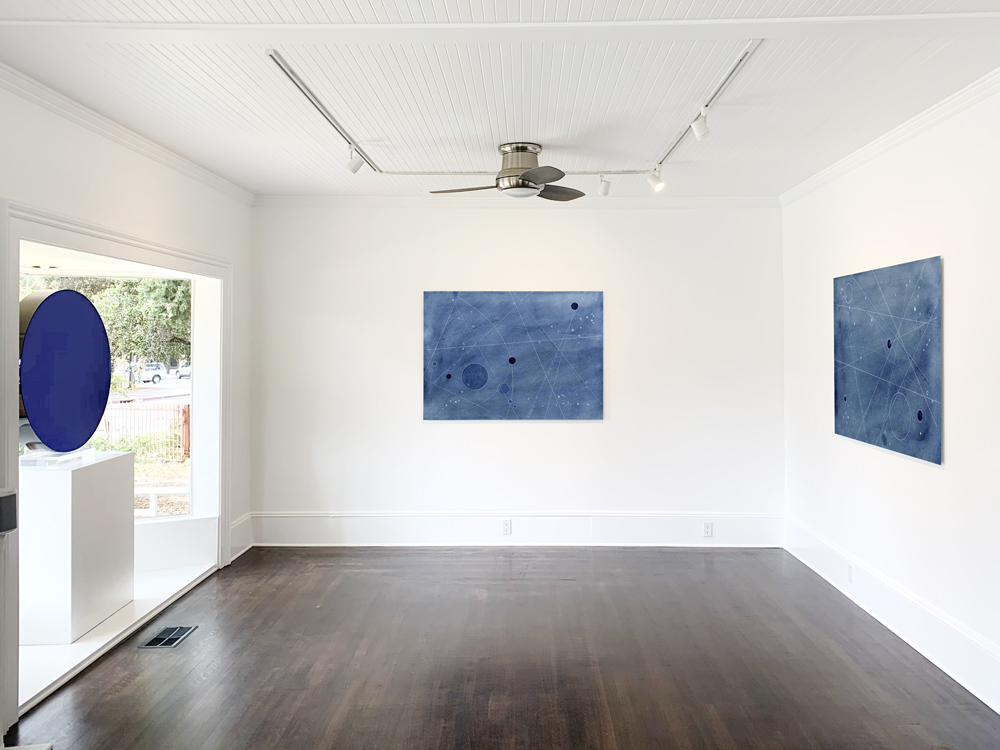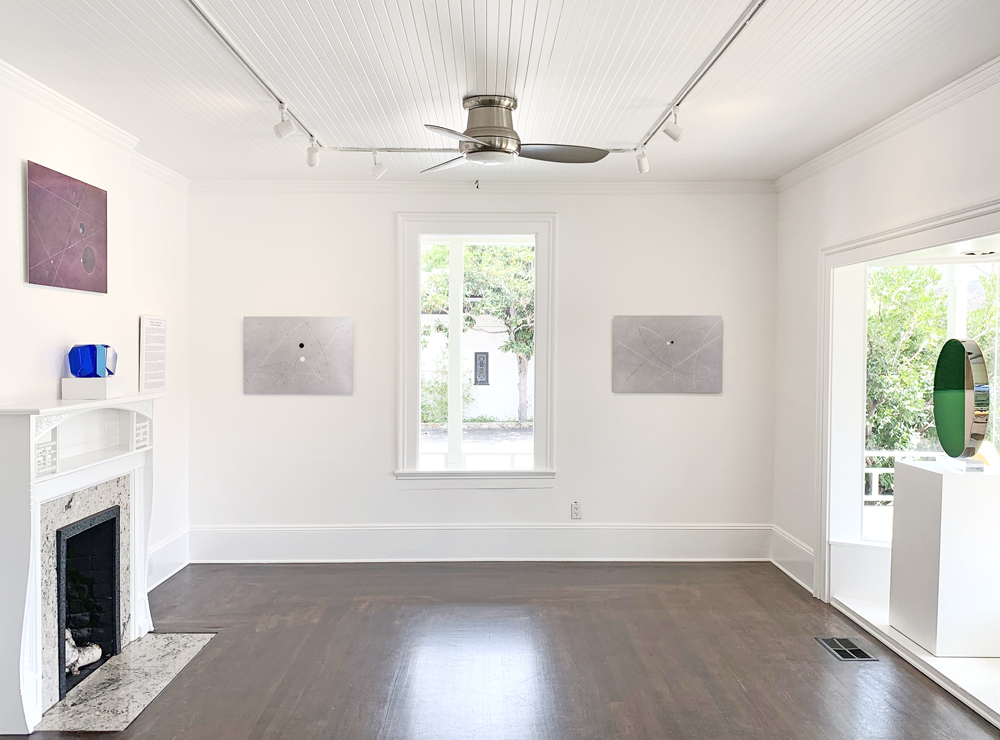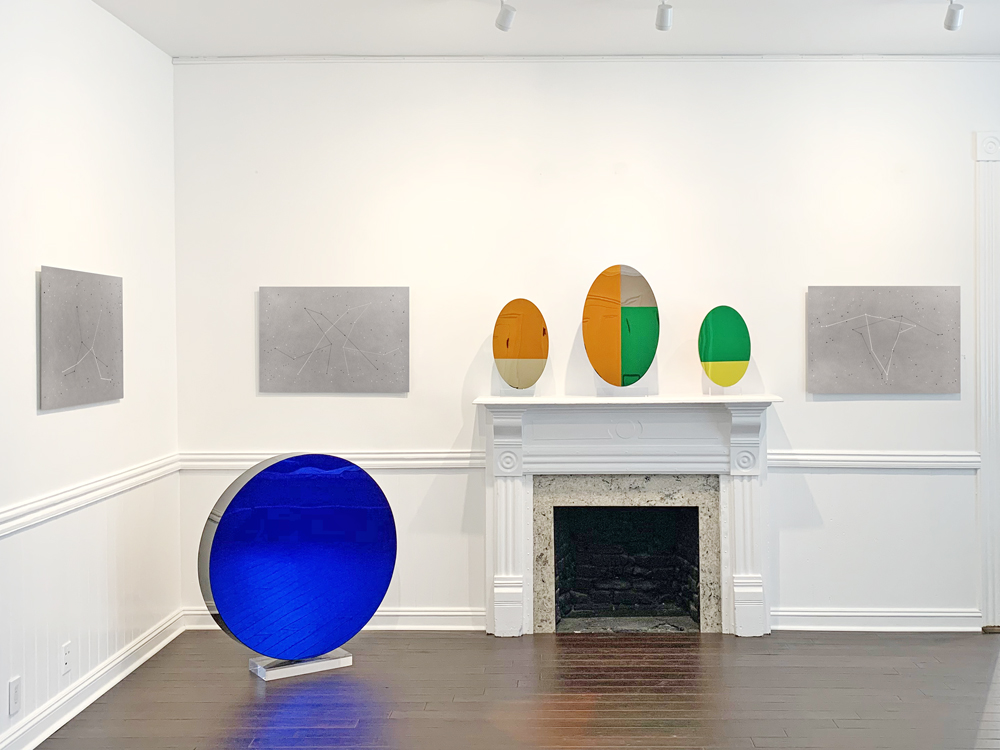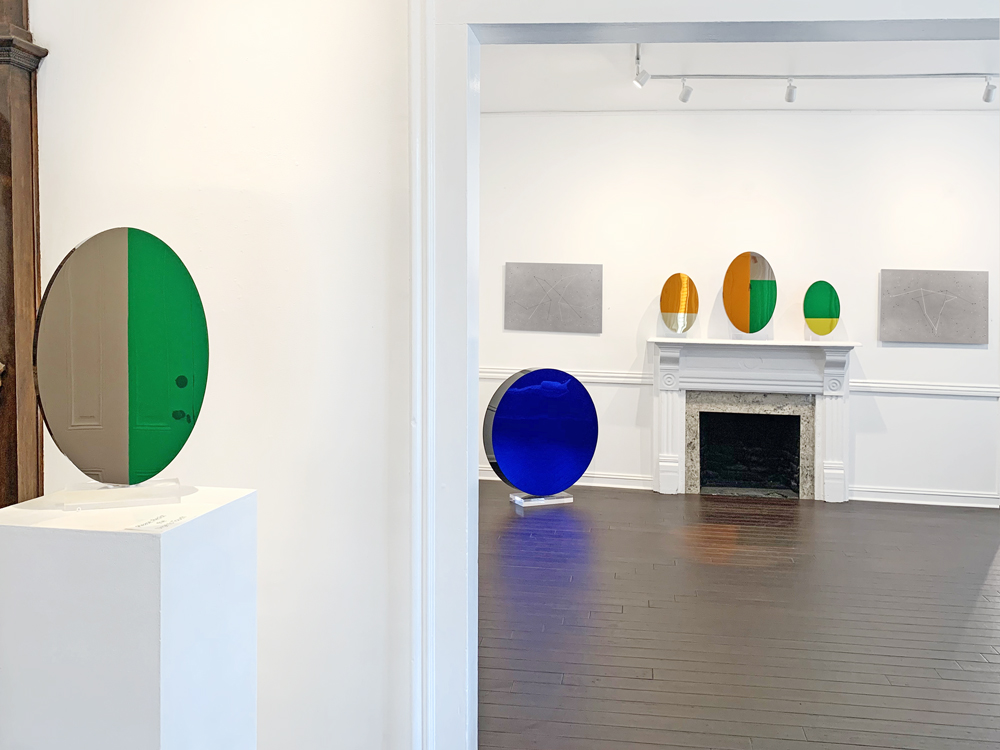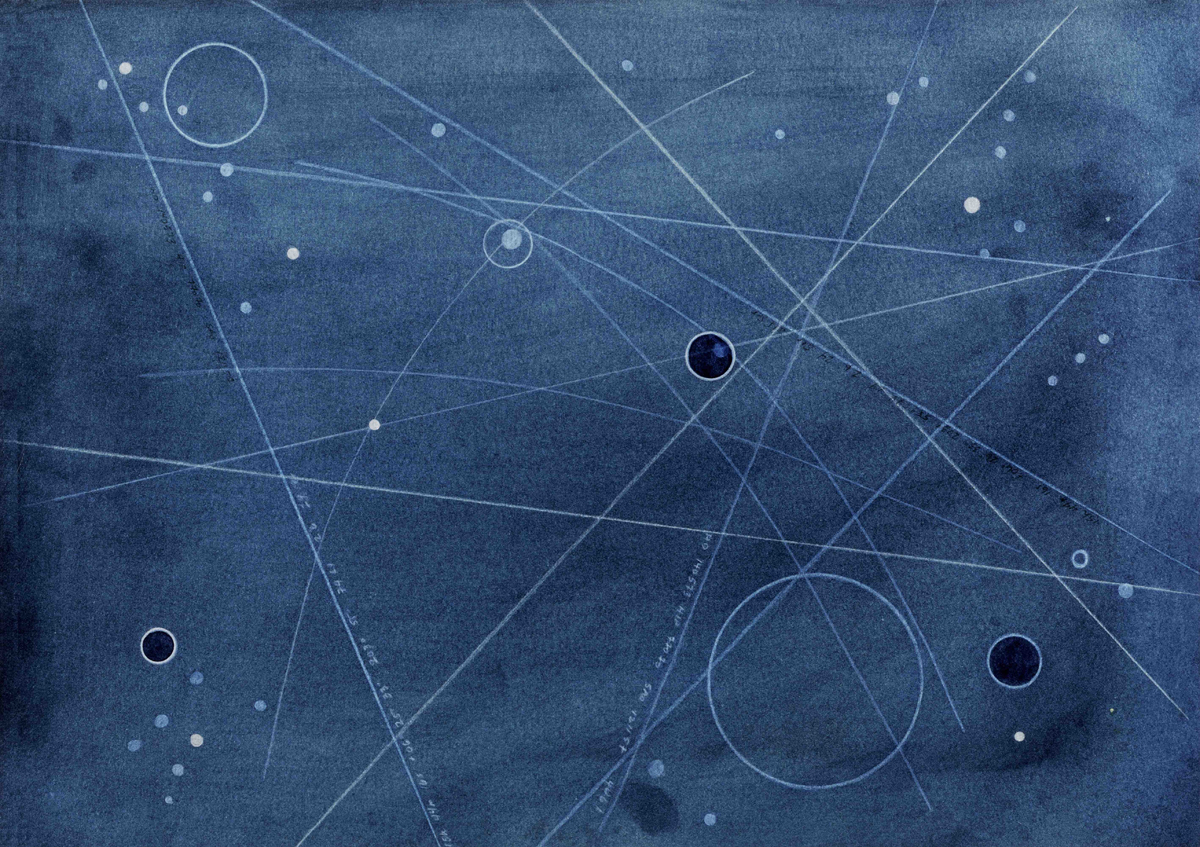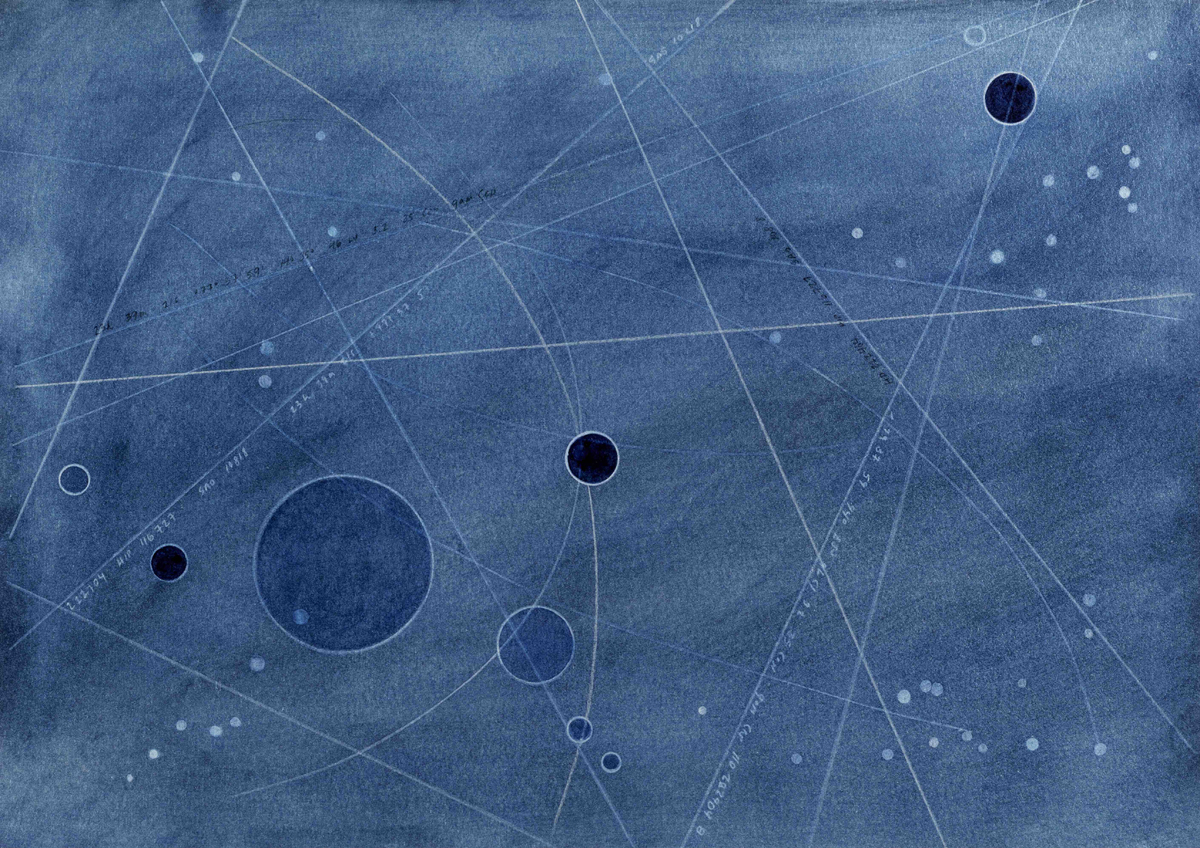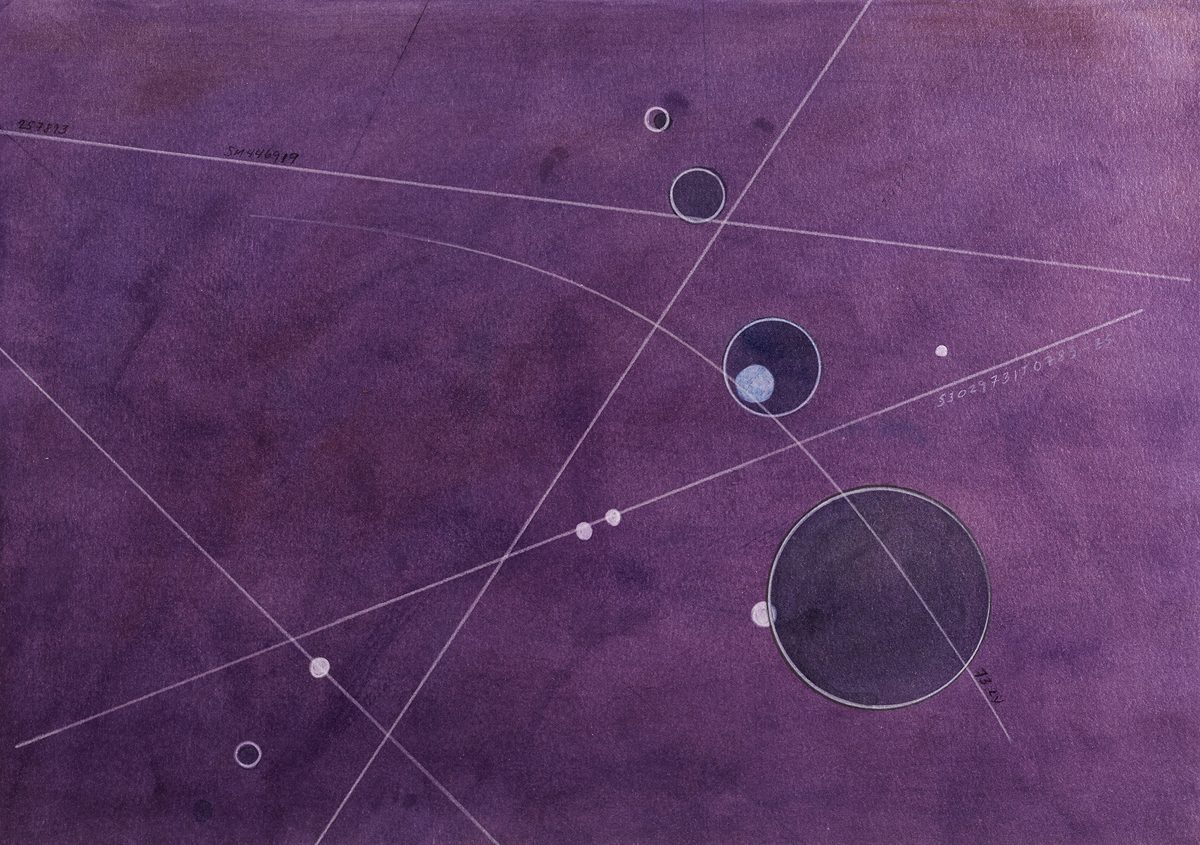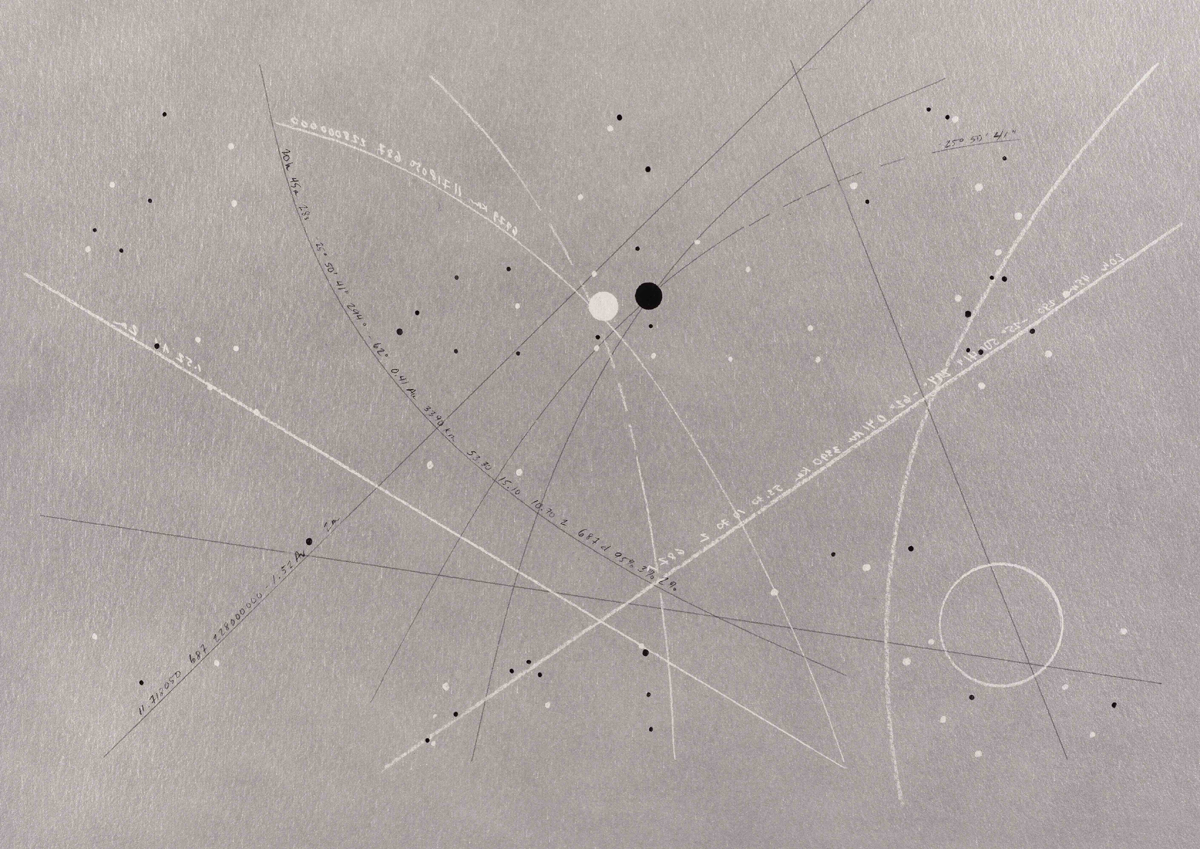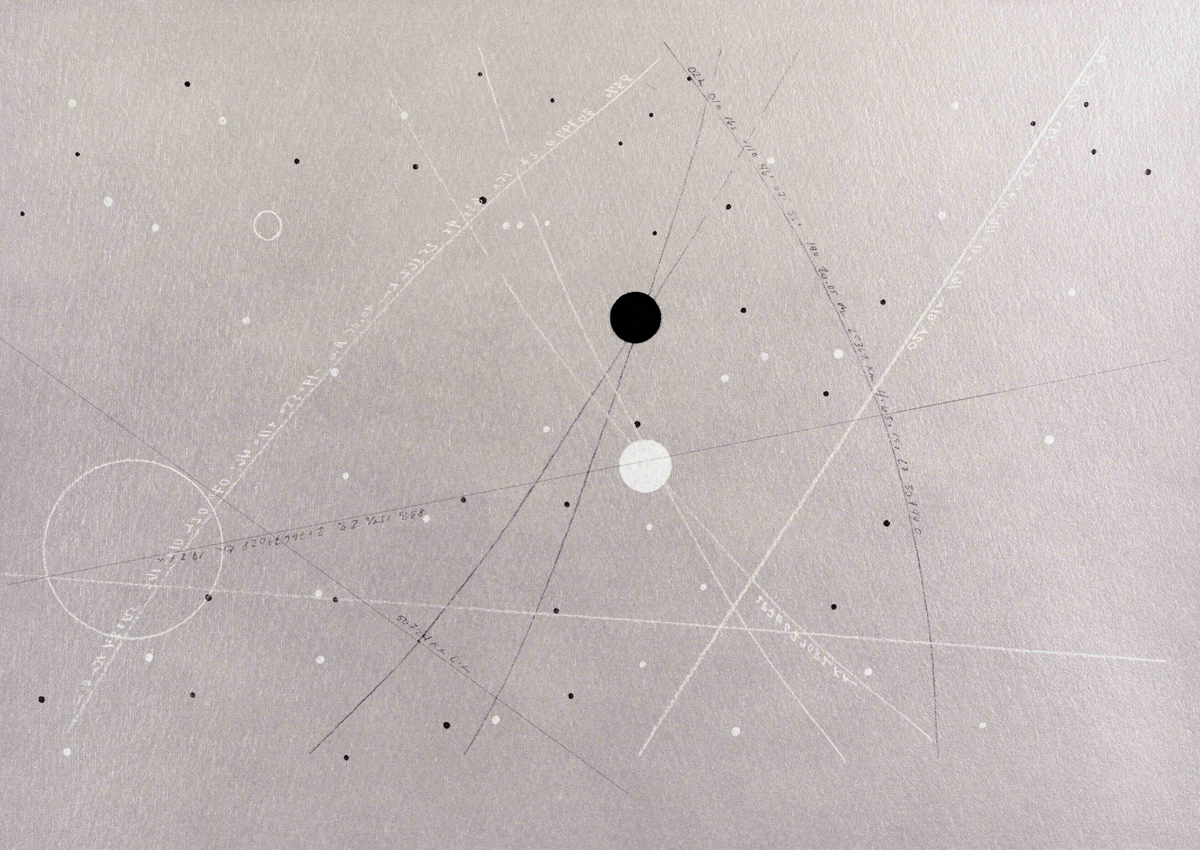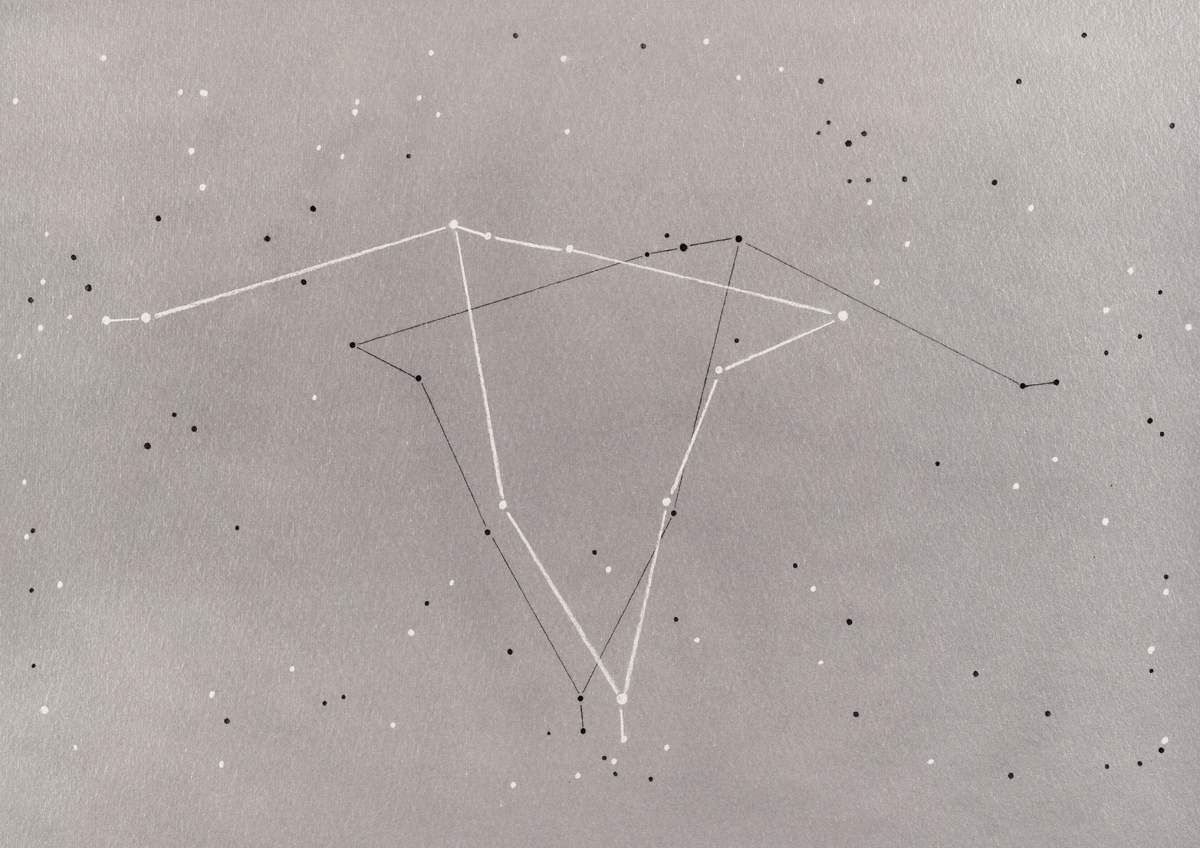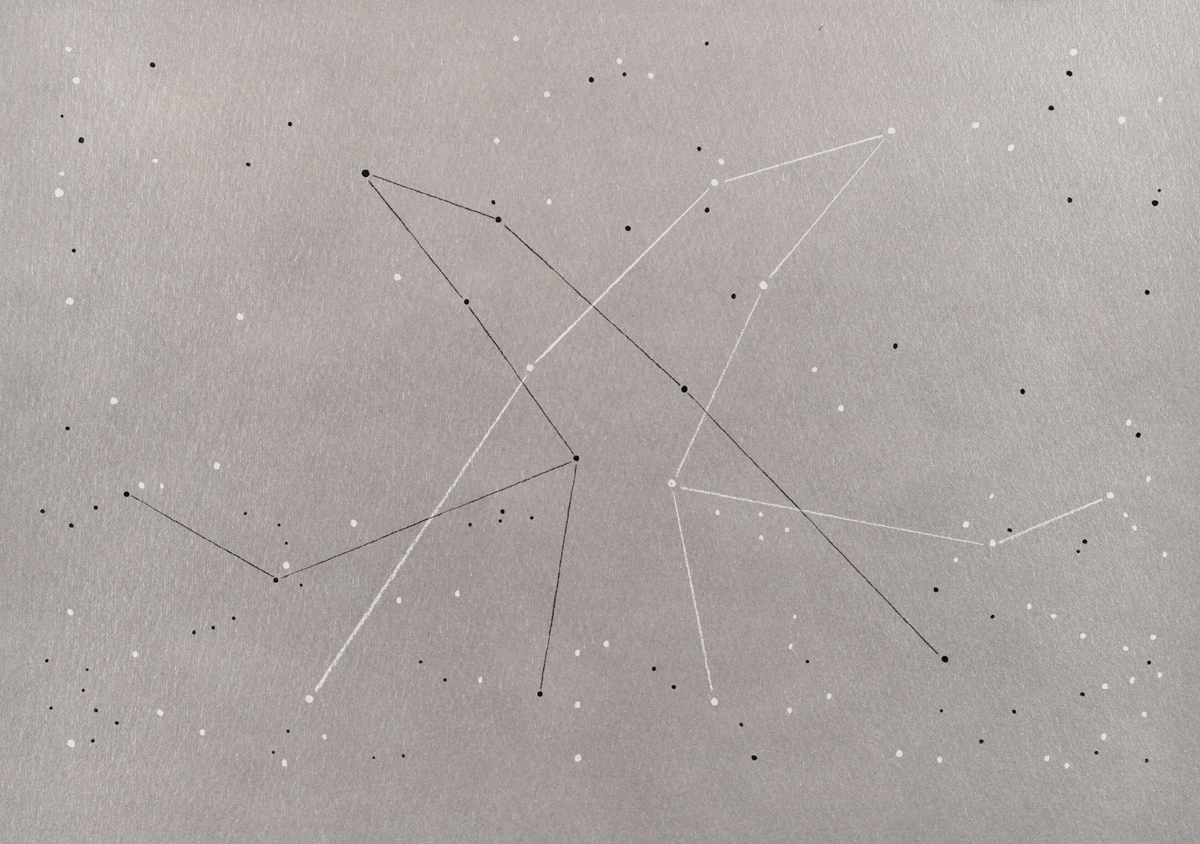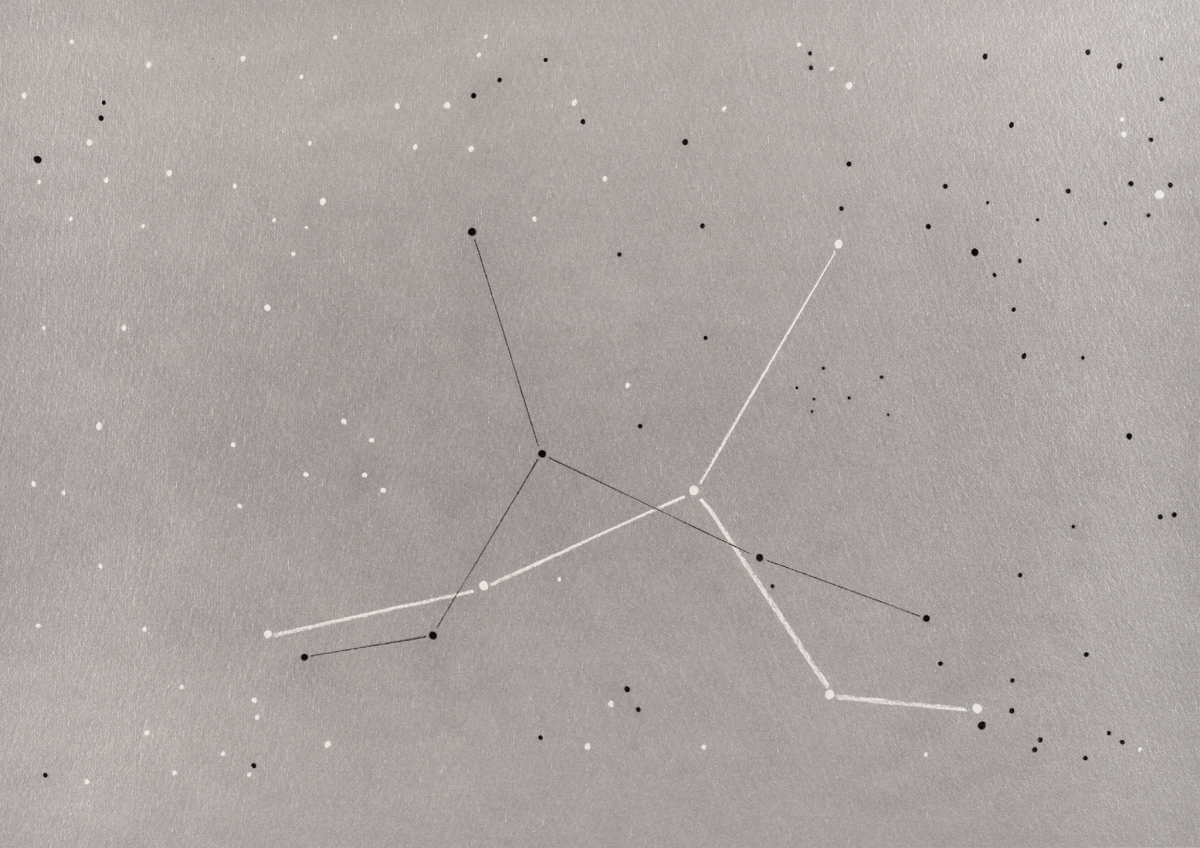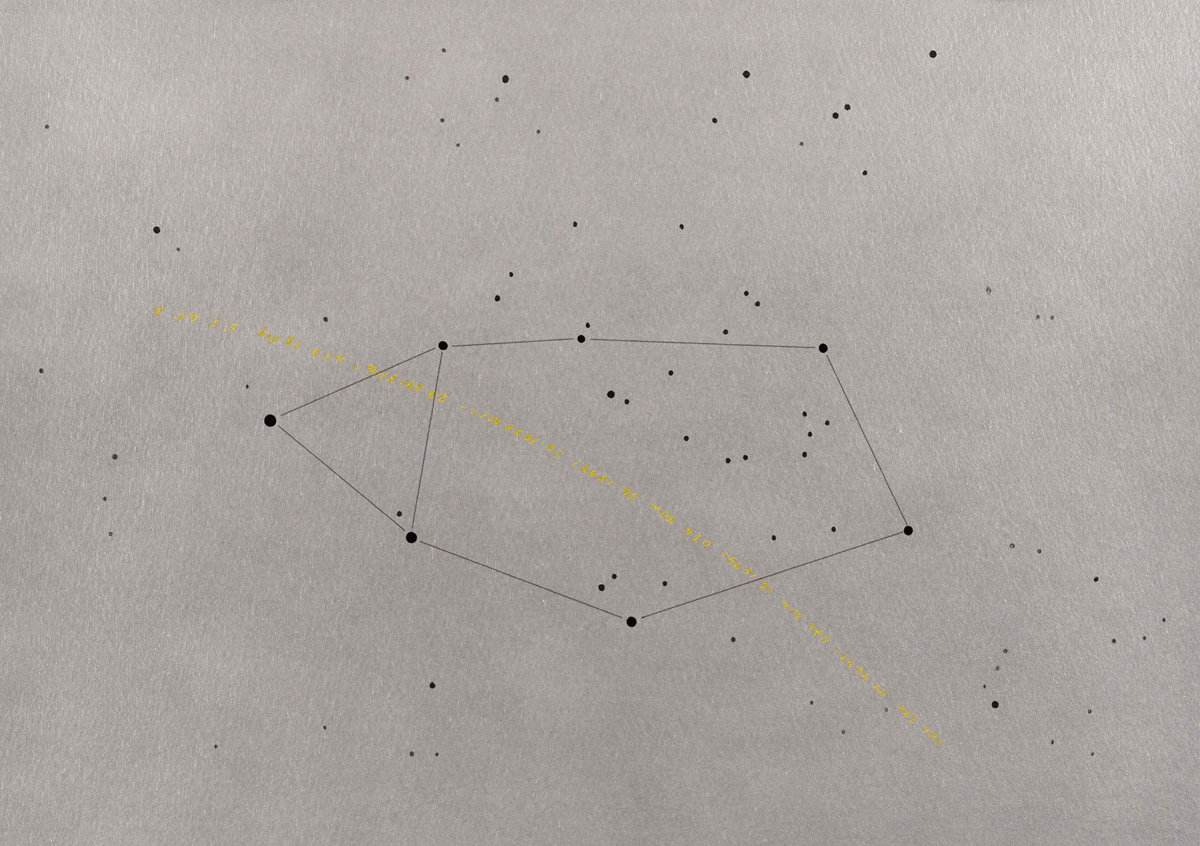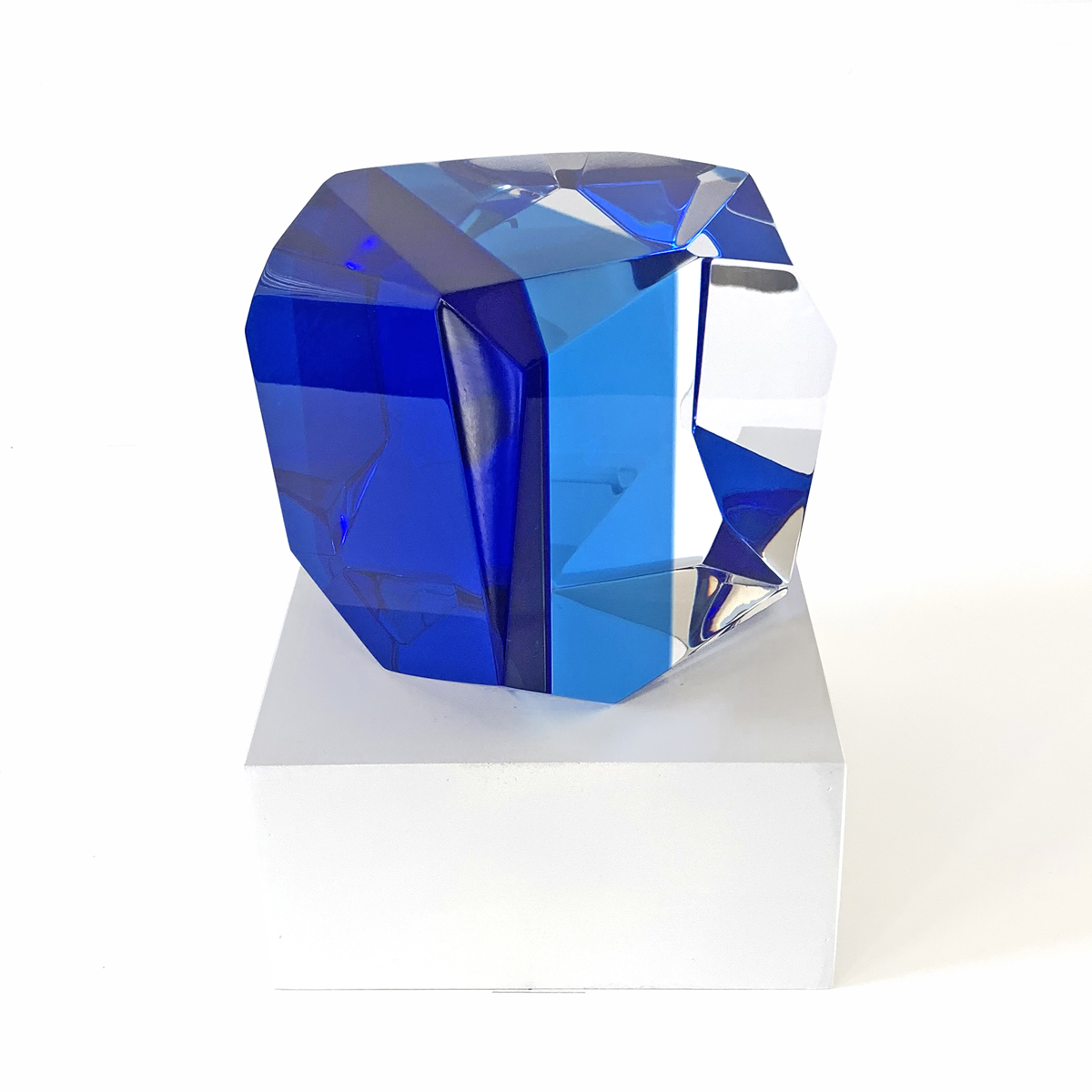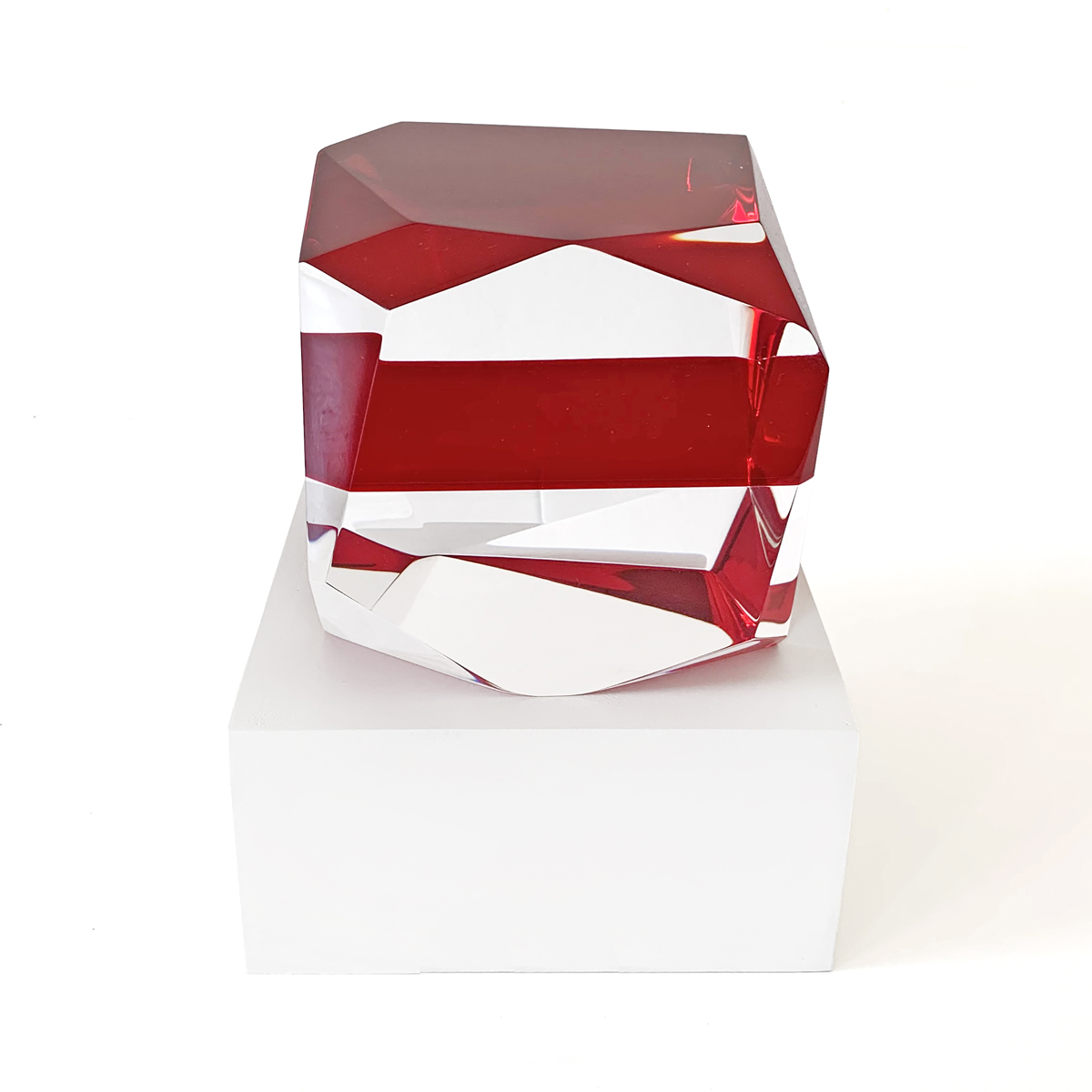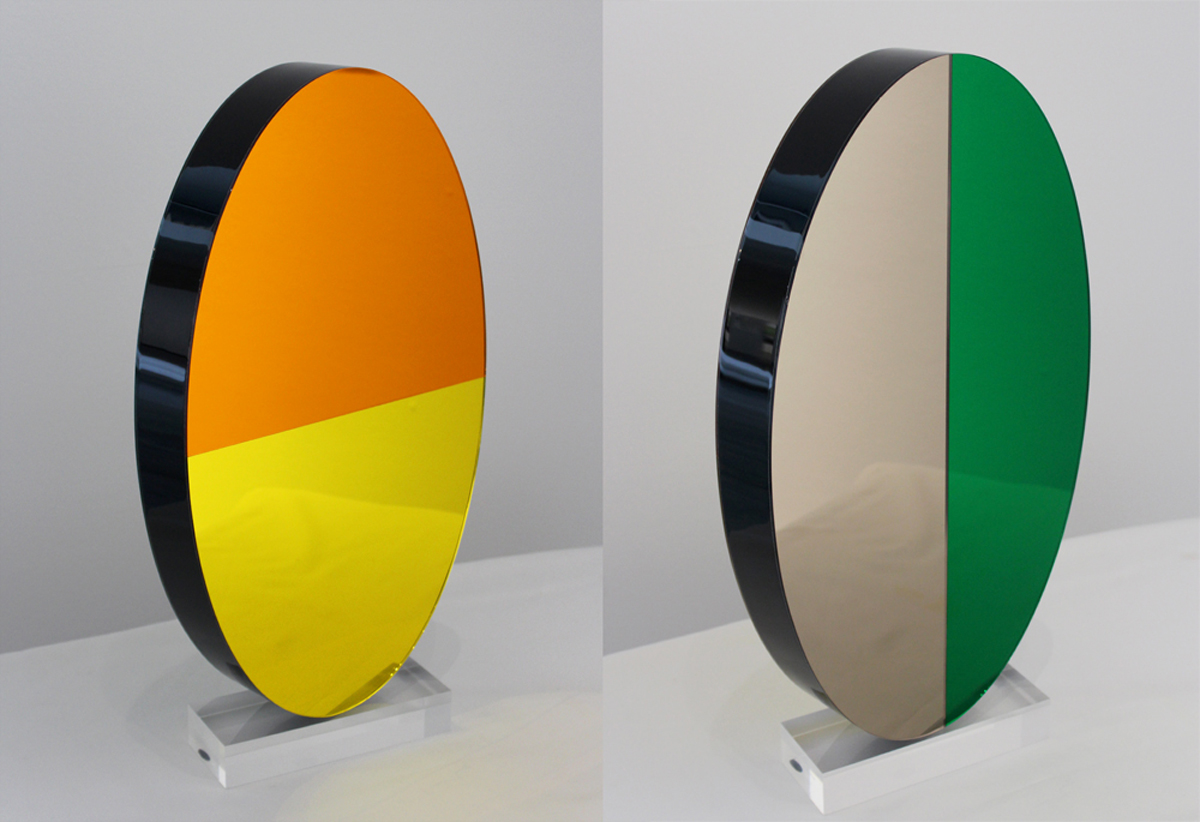March 19 – July 19, 2020
Click here to download sales packet.
Notes on an Exhibition Interrupted by a Pandemic
Shana Mabari
The exhibition Constellatio : Planeta : Stella was installed at Porch Gallery Ojai on a rainy Thursday in March; the following day, California became the first state to issue a mandatory stay-at-home order in response to the rising number of Covid-19 cases in the U.S. Thus, for nearly the entirety of the show’s originally scheduled two-month run, the gallery has been closed to the public—and in that time, it feels as if the entire world has been turned upside down.
The disappointment I felt when the opening reception was canceled and the gallery shut down was in inverse proportion to the excitement and anticipation I’d experienced seven months before when the show was first scheduled. Of course it can feel small to talk about one’s own personal disappointments in the face of a crisis as big as a global pandemic. Still, it’s undeniable that there has been a particular kind of heartbreak in thinking about the exhibition as it has sat in stillness and silence for eight weeks, devoid of people.
A lot of the pieces in the show are related to a larger and more recent body of work centering on the concept of space. In 2018 I was selected to be the first artist to fly aboard a mission of NASA’s Stratospheric Observatory for Infrared Astronomy (SOFIA), which uses a 2.7-meter telescope mounted in a customized 747 flying to a maximum altitude of 45,000 feet to study such astronomical phenomena as black holes and star formation. Thus, it’s probably no surprise that in work that came after that amazing experience I explore our relationship to the cosmos. But I found myself turning over the word space in my mind and thinking about its countless meanings, so much so that I asked a number of diverse professionals with whose paths I’ve crossed during the past twenty years—from astronauts to filmmakers, scientists to a professional rock keyboardist—to contribute their own reflections on the word, which I then assembled into a collection of texts and artworks. Never would I have imagined that by March 21, 2020, the weekend of the opening reception, a new notion of space would have swept the planet—space as in social distance, now almost universally prescribed as no less than six feet, or almost two meters, between one human being and the next. Space in relation to epidemiology. Who knew?
Astrophysical space inspires many emotions, chief among them wonder and amazement, and some degree of fear. The space of our social distancing has until now primarily been marked by the latter, and also sadness, like a kind of innocence lost. It has also been a disorienting space in which to live. As schedules dissolved and both the personal and professional appointments that give our time structure disappeared, I found myself floating through this undifferentiated space lost and unable to focus, not knowing which way was up or down.
The tragedy continues to unfold, and it must not be minimized. But space-time cannot be denied; it pushes us ineluctably forward, into this new and forever changed world. What does this exhibition that was conceived in the old world have to contribute to this new one? Is there any relevance to it anymore? As I’ve thought about this shuttered exhibition sitting in silence in a state of suspended animation as it were, I’ve thought of the work I made in response to my flight aboard SOFIA, the contemplation of space so vast as to seem infinite and to swallow at once anything even remotely close to human-scale. There’s fear in that—terror, even—but also a kind of freedom, the sort of freedom epitomized by the audacity of art-making, the creative act, which takes on new resonance now. The act of viewing art in this new era of face masks and social distancing likewise assumes new meaning. There’s likely to be a new profundity to ordinary things we did before, like popping into a gallery on a Saturday afternoon. A new spirit of wanting to connect, to build and nourish community, to bridge the vastness of space that we’ve felt these past two months yawning so wide between us.
I look forward to sharing this work with the community and am finding within myself a sense of optimism that we will be better, stronger, more resilient and thoughtful as time moves forward, leaning into new lives with new realities but also new possibilities.
Resources for Artists in the COVID-19 Crisis:
Resources for Artists in the COVID-19 Crisis – Emergency grants, freelance resources, legal aid, and more.
List of Arts Resources During the COVID-19 Outbreak
Coronavirus (COVID-19)
Material and Financial Resources for Artists
Arts and Culture Leaders of Color Emergency Fund
Common Field:
COVID-19 Resources for the Artist Organization Field
Santa Barbara County Office of Arts & Culture:
Emergency funding programs for artists and creative professionals
Unuk Serpens – 74 Light Years
Silver Aluminum Print, 40" x 56", 2019. From the Stella Series, Unuk is the brightest star in the Serpens Constellation of the northern hemisphere recorded by 2nd-century astronomer Ptolemy. The layers of blue color throughout reflect its Latin name, Cor Serpentis "the Heart of the Serpent". White lines and markings follow the trajectory of Unuk’s movement as well as the neighboring planets and stars. The galactic location including right ascension, declination and apparent magnitude is described in astronomical-specific mathematical information. Unuk is 74 light-years away from earth.
Errai Cepheus – 46 Light Years
Silver Aluminum Print, 40" x 56", 2019. From the Stella (“Star”, Latin) Series, Errai is the third brightest star in the Cepheus Constellation. The arcs and lines celebrate the star’s movement as seen from the Mediterranean island of Ibiza between the mainland of Spain and Morocco. The light and dark astronomical-specific mathematical information including right ascension, declination, radial velocity, luminosity and apparent magnitude move along the interstellar pathways describing the star’s individual characteristics and galactic location. Errai is 46 light-years from Earth.
Gienah Cygnus – 73 Light Years
Silver Aluminum Print, 20" x 30", 2019. From the Stella Series, Gienah is the fifth brightest star in the Cygnus Constellation from Johann Bayer’s 1603 Uranometria atlas of bright stars. 73 light-years from Earth, Gienah is wildly vivid and mesmerizing against the night sky. The markings celebrate the star’s luminosity, 62 times our Sun. The only violet colored print from the Stella series, Gienah celebrates the astonishing electromagnetic spectrum that allows us to gather information based on wavelengths. The galactic location including right ascension and declination is described in astronomical-specific mathematical information.
Mars 6779 km
Silver Aluminum Print, 20" x 30", 2019. From the Planeta Series, Mars is the fourth planet from the Sun in our Solar System. The aluminum print shows two overlapping views of Mars: a “positive view,” in black which is the view of the planet looking up from the earth, and a “negative view,” in white which is the view of the planet looking down on the earth. The overlapping views remind us that we are part of and in space at all times, never separate. Astronomical-specific mathematical information along the arcs and lines describe the planet’s galactic location and specific characteristics including right ascension, declination, azimuth and atmosphere. Mars has 2 moons and an orbital period of 687 days.
Uranus 50,724 km
Silver Aluminum Print, 20" x 30", 2019. From the Planeta Series, Uranus is the seventh planet from the Sun and named after the ancient Greek deity of the sky. The aluminum print shows two overlapping views of Uranus: a “positive view,” in black which is the view of the planet looking up from the earth, and a “negative view,” in white which is the view of the planet looking down on the earth. When it comes to (outer) space, there are rules and no rules at the same time. Forward is also backward; up is down; inside is outside; and sideways is also the other way. Confusion is part of the poetry and humans on earth are continually part of it. Astronomical-specific mathematical information along the arcs and lines describe the planet’s galactic location and specific characteristics including right ascension, declination, azimuth and atmosphere. Uranus has 27 moons and an orbital period of 30,799 days.
Aquila
Silver Aluminum Print, 20" x 30", 2019. From the Constellatio Series, Aquila (“Eagle”, Latin) is a constellation on the celestial equator associated with the eagle that kidnapped Ganymede, a son of one of the kings of Troy and a lover to Zeus in Greek-Roman mythology. The elemental geometric form and clean linearity derived from astrophysical observations reflect the beauty inherent in the ability of mathematics to describe natural phenomena, a beauty that might be said to underlie existence itself. Aquila was one of the 48 constellations described by the second-century astronomer Ptolemy. It had been earlier mentioned by Eudoxus in the fourth century BC and Aratus in the third century BC.
Andromeda
Silver Aluminum Print, 20" x 30", 2019. From the Constellatio Series, Andromeda, known as "the Chained Woman", is a constellation north of the celestial equator named for the daughter of Cassiopeia, who was chained to a rock. While the series' Latin name—for “constellation,”—hark back to the origins of modern astronomy in the discoveries of Claudius Ptolemy in 2nd century ce and other ancient astronomers, and the title of the individual print reflects the enduring influence of Greco-Roman mythology in identifying astronomical objects, such historical associations form but one aspect of the works’ multivalence. Andromeda is also associated with the Mesopotamian creation story of Tiamat, the goddess of Chaos.
Camelopardalis
Silver Aluminum Print, 20" x 30", 2019. From the Constellatio Series, Camelopardalis is a large but faint constellation of the northern sky representing a giraffe. There are two overlapping views of Camelopardalis: a “positive view,” in black which is the view of the constellation looking up from the earth, and a “negative view,” in white which is the view of the constellation looking down on the earth. Even as this work is rooted in personal observations from my particular vantage point under the night skies on Ibiza, it incorporates elements of an advanced science whose concepts many of us struggle to comprehend, transforming seemingly simple images into complex epistemological riddles.
Auriga
Silver Aluminum Print, 20" x 30", 2019. From the Constellatio Series, Auriga is a constellation on the celestial equator, one of the 88 modern constellations and was among the 48 constellations listed by the 2nd-century astronomer Ptolemy. Its name is Latin for “(the) charioteer”, associating it with various mythological beings. The choice to infuse the original drawing onto aluminum to make the final print reflects not only the metal’s historical significance to aerospace engineering but also the fact that aluminum, so often associated with technological advancement and heavy industry, is a naturally occurring element across the universe. Incorporating astronomical-specific mathematical information such as azimuth, right ascension, declination, apparent magnitude, radial velocity, distance from earth in light-years, eccentricity, and synodic period creates a deceptive simplicity to the elegance of the work.
Meteor Blue
Acrylic, 7" x 7" x 7", 2020. From the Meteor Series. This light and dark solid acrylic blue Meteor celebrates the electromagnetic spectrum relating stellar color to stellar temperature. Blue stars are much hotter than our Sun, approximately 25,000 Kelvin = 44540.33 F. The multiple facets reflect and multiply where light waves pass through without hesitation or inhibition exploding in all celestial directions.
Meteor Red
Acrylic, 7" x 7" x 7" 2020. From the Meteor Series. This solid acrylic red Meteor celebrates the electromagnetic spectrum relating stellar color to stellar temperature. Red stars are much cooler than our Sun, approximately 3,000 Kelvin = 4940.33 F. The transparent material shares a space of movement were light passes through unique to the molecules of the mass. The piece transforms with perspective, where angles, positions, distances change rapidly on courses more ancient than the human species.
Diametros Petal, Red | Orange | Blue
Acrylic, Mirror, 36" x 36" x 5", 2016. Diametros ("Diameter", Latin) Petal. Recognizing the geocentric model, a superseded description of the Universe with Earth at the center, where the Sun, Moon, stars, and planets all orbited in a perfect circle. This model was the predominant description of the cosmos in many ancient civilizations, such as those of Aristotle in Classical Greece and Ptolemy in Roman Egypt. The Platonic ideal of perfect forms including true circles to organize space advanced the notion that the cosmos consisted of ideal forms that represented Truth, Good and Equality. In this work I strive to celebrate the origins of astronomy and mathematics. To find the overlaps, the sweet spots per se between the geometric and organic, the masculine and feminine.
Leukos Petal, Orange | Yellow | Bronze | Green
Acrylic, Mirror, 22" x 11" x 2", 2018. Leukos ("Light", Greek) Petal. "I have the answer, the orbit of the planet is a perfect ellipse" - Johannes Kepler. Kepler’s laws of planetary motion include that every planet’s orbit is an ellipse with the Sun at a focus. A revolutionary idea which moved the center of the universe from the Earth to the Sun infuriating the church by no longer putting man at the center of the cosmos. Celebrating revolutionary ideas that arose through fearless research in astronomy, cosmology and mathematics. Finding the overlaps and sweet spots between the geometric and organic, the masculine and feminine using shifting vertical and horizontal lines to inform a gracefulness balance amongst the chaos.
Porch Gallery Ojai presents Constellatio : Planeta : Stella – New Works by Shana Mabari. Mabari was the first artist invited to fly aboard a mission of NASA’s stratospheric observatory for infrared astronomy (SOFIA) in December 2018. In 2020, she introduced new works inspired by space exploration, including the sculpture series “Meteors,” and three interrelated series of prints, “Constellatio,” “Planeta,” and “Stella,”
Throughout her professional practice, Los Angeles-based artist Shana Mabari directly represents the intersections of art and science, as evidenced by her exhibitions over the last decade. She explores the dynamics of visual perception, and investigates the ways in which we experience physical space through her use of color, light, reflection, and geometric form. Mabari’s sculptures, two dimensional works, and installations exist on a continuum with the Light and Space movement that originated in California in the 1960s. Her newest work is inspired by astronomical observations and space exploration.
Mabari also has a studio practice on Ibiza, Spain, where she spent the summers of 2018 and 2019, delving into three series of interrelated prints that originated in astronomical observations taken under the nighttime Mediterranean skies – “Constellatio,” “Planeta,” and “Stella.” During this time, she also began developing her latest acrylic sculpture series, “Meteors.”
In between the two summers, Mabari was selected to be the first artist to fly aboard a mission of NASA’s Stratospheric Observatory for Infrared Astronomy – SOFIA – which uses a 2.7-meter telescope mounted in a customized Boeing 747 aircraft. SOFIA flies to a maximum altitude of 45,000 feet to study such astronomical phenomena as black holes, magnetic fields at cosmic scales, and star formation. She took the flight in December 2018, and says, “It was an extraordinary opportunity to witness firsthand some of the astounding ways in which astronomers continue to radically expand our collective field of vision into the universe.”
Each drawing that forms the basis of the prints shows two overlapping views of the same object: a “positive view,” of the object looking up from the earth, and a “negative view,” of the object looking down on the earth. Many of them also incorporate astronomical-specific mathematical information, lending a deceptive simplicity to the elegance of the work. Mabari’s choice to infuse the original drawings onto aluminum reflects not only the metal’s historical significance to aerospace engineering, but also the fact that aluminum, often associated with technological advancement and heavy industry, is a naturally occurring element across the universe.
In coordination with the new body of work, Mabari has also curated the essays for Space, the companion book to The Light of Space, which comprises a thoughtful collection of 15 original written works from a diverse range of writers from varied practices. Each author’s work is paired with images from multiple artists selected by Andi Campognone, Museum Director and Senior Curator for Lancaster Museum of Art and History (MOAH). Books are available through Amazon.
Mabari was born in Los Angeles, California. She has traveled extensively, and lived in Paris, Northern India, and Tel Aviv. Her education includes studies at the École Nationale Supérieure des Beaux-Arts de Paris and Otis College of Art and Design in Los Angeles. She holds a patent for the design of “Dynamic Spatial Illusions,” a portable version of a visual and sensory experimental environment. She is a recipient of the Center for Cultural Innovation ARC grant.

